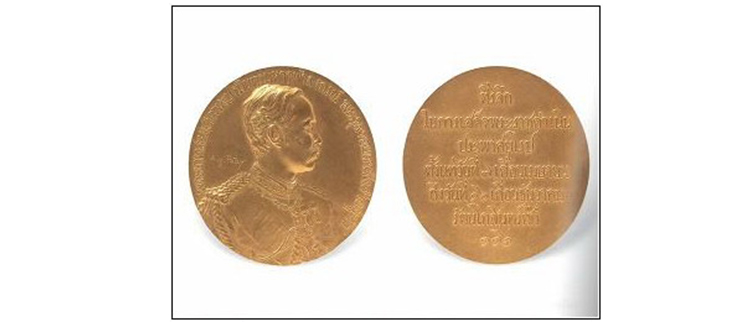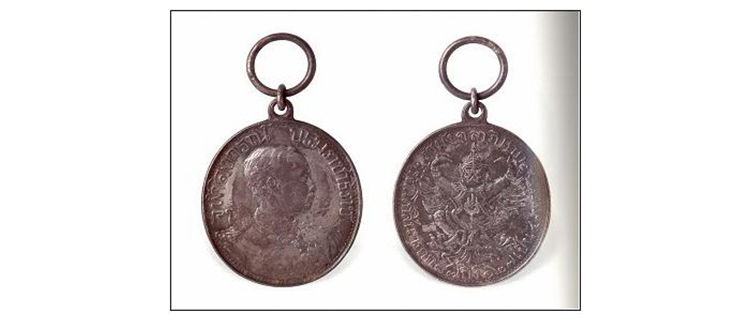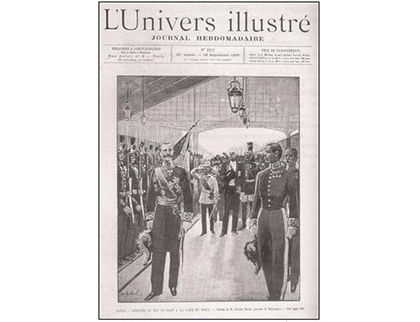King Chulalongkorn(King Rama V)
King Chulalongkorn(King Rama V)
His Majesty King Chulalongkorn (King Rama V) was known for his great foreign policy. Western civilization was embraced to move forward and modernize the country in many parts i.e., education, cultures, traditions, transportation and finance. Through the policy, Siam has survived European colonization. King Rama V’s foreign approach to national development includes royal visits to Europe, in order to improve diplomatic relations and to learn Western civilization and new science. Since the ambitious goal was to ease political conflicts between Thailand and France, the first destination was France. The objective was not only to strengthen the relation but also to gain knowledge about French Renaissance. With great interest, the King visited the old and famous Paris Mint called La Monnaie de Paris.
L’Univers ilustre (French newspaper) published the news of King Chulalongkorn’s visit to France.
During the reign of King Rama V, several European powers began to exert their influence on other territories, including Southeast Asia, with the main objective of gaining colonies and precious resources. This eventually led to the Franco-Siamese War of 1893 and the signature of Franco-Siamese Treaty, which contained several conflicts such as Siam’s fortifications right within a strip 25 kilometers wide on the west bank of the Mekong, the French occupation of Chantaburi province, the Thais under French control, the French seeking residency in Siam, and the problem about Cambodian territory (Battambang, Siem Reap and Sisophon). Following the crisis, King Rama V decided to make a Grand Tour to Europe. The first voyage was made from 7 April to 16 December 1897, with major goals to gain recognition in Europe, to develop diplomatic relations with France, to experience the western administration and to learn new science. France was the first official destination by reason of the poor diplomatic relation. However, as the King had barged in Europe, the conflicts back in Siam grew more violent. Russia’s interference was requested to find an agreement for the tour plan in France. The final official date was 11-17 September, 1897, and the King was granted an honorable reception. The French government provided a tour of the King’s interests, one of which was La Monnaie de Paris on 16 September 1897, as appeared in a royal writing;
"During a royal visit at Musée du Louvre, I have observed the famous sculpture Venus de Milo. At the national library, I witnessed ancient Thai inscriptions as well as an eternal alliance between Siam and Louis XIV of France. Later, I went to the museum called Monnaie (Musée de la Monnaie), where the precious from Siam, Khmer, Laos, China, Japan and the East were kept. La Monnaie de Paris was the last tour, led by the French Minister of Finance. I have seen samples of gold and silver coins. In the evening, the Foreign Ministry arranged an honorable dinner reception…”
After the visit at La Monnaie de Paris, King Rama V ordered the making of 2 commemorative medals as follows,

Commemorative medals of King Chulalongkorn’s first Grand Tour in 1897
Commemorative medals of King Chulalongkorn’s first Grand Tour in 1897 are the medals of history made during the first European visit. Depicting the King on the facing side, they are of great value and well reflect how ambitiously King Rama V attempted to make European recognition of Siam. The round flat 50-mm-diameter medals were minted with coinage metals in gold, silver and bronze. The silver says "MONNAIE DE PARIS ARGENT” on the edge, the bronze "MONNAEI DE PARIS BRONZE”. All bore the King’s portrait facing right on the obverse, with the royal signature "Phra Bat Somdet Phra Poraminthra Maha Chulalongkorn Phra Chunla Chom Klao Chao Yu Hua” on the right and the designer’s name "Aug. Patey” on the left. The reverse side carries the message "Memento from the Grand Tour from 7 April to 16 December 1897”. They were gifts for royal members and accompanying officers.
Prabas Mala Medals
The Prabas Mala Medals are royal decoration to be given, together with the above medals, to the accompanying officers for the use on the left breast side. To the ladies of the court, they came with a dragonfly-shape ribbon for the use on the left shoulder. The medals were minted in gold, silver and bronze colors. With 50-mm diameter, they are flat and round, attaching to a blue-yellow-red silk ribbon. On the obverse side appear the King facing left and the royal signature "Phra Bat Somdet Phra Poraminthra Maha Chulalongkorn Phra Chunla Chom Klao Chao Yu Hua” on the edge. The name of the medal desiger "Aug. Patey” is on the left side of the King’s portrait. The reverse side carries the message "Memento from the Grand Tour from 7 April to 16 December 1897”. Mr. Aug. Patey did both the work of modelling and printing.
It is believed that the medals were to improve the diplomatic relation between Siam and France and to ease the diplomatic tension, in order to protect the highly important possession of Siam – independence.
Ten years later, King Rama V made the second European Grand Tour from 1906 to 1907 (27 March 1906 to 13 November 1907), the total time of 6 months and 23 days. The kidney disease was the main purpose of the trip. The King’s personal German doctor, Dr. Bomer, recommended changing the location for suitable weatheras the treatment. During the tour, the King entered France six times and frequently visited Paris. Here, the King had his statue made by the sculptor named Carolus Duran in San Remo and the Equestrian Monument cast at the foundry Les Frères Susses, sema-shaped medals and commemorative medals on the occasion of the longest reign minted by the Paris Mint, the last two of which as stated in the royal writing number 24, 84th night, on 18th June in Paris, France;
"We took the train from Baden-Baden to France; arrived in Paris, stayed at the Royal Thai Embassy; Thai students came to visit; I met with La Monnaie de Paris (Paris Mint)’s modeler who will make the Grand Tour’s commemorative sema-shaped medals and the commemorative medals on the occasion of the longest reign as of Somdet Phra Ramathibodi II (Phra Chettathiraj) of Ayutthaya; dinner at the Royal Thai Embassy.”
During the second Grand Tour, King Rama V ordered from La Monnaie de Paris the mint of two medals as follows;

Second Grand Tour’s commemorative sema-shaped medals
The second Grand Tour’s commemorative sema-shaped medals are again made by Mr. Auguste Patey, the sculptor with highly skill in bas-relief. A 25-centimeter bronze metal was used as the model for these medals and for further mint. The medals were made in gold, silver and white gold colors. They are sema-shaped, holed on the top, with the size of 2.6 x 3.4 centimeter. The obverse side bears the King’s portrait facing right, in fully-decorated royal service uniform. The royal signature "Chulalongkorn” appears right above, "Borom Rachathirat” on the bottom. Next to the King’s right shoulder is the sculptor’s name, "Aug. Patey”. The medal’s reverse side carries the message "The return from Europe in 1907”. The amount of 30 medals was made in gold, 500 in silver and 100,000 in white gold. They were given as an award to officers, children and the regent’s officers (in charge of His functions as the King made the second Grand Tour). Only the gold medals were given as gifts to noble children and royal members.

The commemorative medals on the occasion of the longest reign
The commemorative medals on the occasion of the longest reign (with Garuda) were granted to officers and court officials in the fortieth anniversary celebrations of King Rama V's Accession to the Throne on 10 September 1908. The medals were produced in gold, gold plated and silver. They come in oval shape and holed for ribbon attachment. The size is 3 x 2.6 centimeter. The obverse side bears the King’s portrait facing right, in fully-decorated royal service uniform. The royal signature "Chulalongkorn” appears on the above left, "Borom Rachathirat” on the above right. On the reverse side are garuda with the Chakri dynasty emblem discus and trident, together with the message "Ruby Jubilee – from 1868 to 1908 – 40 years”. The total minting amount was 30 in gold, 400 in gold plated and 5,500 in silver. Mr. Auguste Patey modeled the facing side of the medal, while Prince Narisara Nuvadtivongs made the design for the reverse side.
To summarize, during the reign of King Rama V, the European colonialism reached the Southeast Asia and caused serious conflicts between Siam and France. In consequence, the King made the Grand Tour to Europe, in order to ease the political tension. The first Grand Tour was in 1897, having France as the main destination. King Rama V gained modern knowledge for Siam development and also visited the Paris Mint, where the commemorative medals and the Prabas Mala medals were minted and later given as gifts to royal members and accompanying officers. In 1906, the second Grand Tour happened for the King’s health treatment in Europe as recommended by doctor. During the trip, the King often visited France to have His statue and the Equestrian Monument casted and the two stocks of commemorative medals made at the Paris Mint. After having returned from the Grand Tour, the King ordered the mint of 1-Baht coins bearing His portrait and Airavata (commonly known as mustache coins) for domestic currency circulation. Unfortunately, the coins arrived in Thailand as the King had passed away. King Rama VI therefore used them as memory coins for the royal funeral of His father. One significant feature on all the medals and coins that King Rama V ordered from La Monnaie de Paris is that they all share the same graceful portrait on the facing side.
Translated from
Jarinya Bunamornwit. (2014). Medals made by La Monnaie de Paris from King Chulalongkorn’s European Tour. (Thai Version) Retrieved August 14, 2014, from Pavilion of Regalia, Royal Decorations and Coins e-museum: http://emuseum.treasury.go.th/






